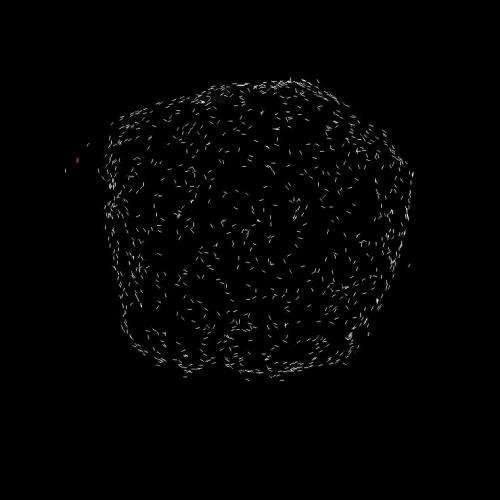Discovering one reason why swarming evolved offers tantalizing clues on how intelligence developed

Many animals – from locusts to fish – live in groups and swarm, but scientists aren't sure why or how this behavior evolved. Now a multidisciplinary team of Michigan State University scientists has used a model system to show for the first time that predator confusion can make prey evolve swarming behavior.
Swarming allows groups of animals to accomplish tasks that they can't do alone, such as defending themselves from a much larger predator.
"There are both costs and benefits to swarming and all other behaviors," said Christoph Adami, MSU professor of microbiology and molecular genetics. "The benefits are discussed all the time. But the litmus test is whether a behavior evolves because of those benefits. If it doesn't evolve, it doesn't mean it's not beneficial, but if it does evolve, it's proof that the behavior has benefits that outweigh its costs. Our model system shows that predator confusion was enough of a selection pressure to evolve swarming behavior in prey."
The paper "Predator confusion is sufficient to evolve swarming behavior," is published online today by the Journal of the Royal Society Interface.
"In our computational model system, swarming evolved as a defense to exploit the predator confusion effect," said Randal Olson, computer science graduate student and lead author of the paper. "Rather than seeing just one or two prey when the predators attack, which is what happens when prey scatter, swarming makes the predators see many prey, which confuses them and allows more prey to survive."
The researchers used a computer model system where the predators and the prey continuously interacted. The system selected prey and predators that evolved survival-enhancing behaviors – either eating prey (the predators) or avoiding being eaten (the prey). Each experiment was replicated more than 100 times to make sure that the behavior evolved due to predator confusion and not just by chance.
Studying the evolution of swarming is extremely difficult to do in a real-world setting. Generations of animals can't be reanimated, despite what Jurassic Park would have one believe. In real-world swarms, it's also very difficult to examine each of the elements that may affect swarming (such as predator confusion) in isolation, to see if they affect the behavior's evolution. So the researchers used their simplified model to look at just one aspect: the fact that predators become confused if they see too many prey.
"Chance does play a huge role in evolution," Adami said. "But if we repeat something 1,000 times, we start to see patterns and can talk about averages. Evolution is a sequence of events influenced by chance."
All the study's authors are members of the BEACON Center for the Study of Evolution in Action, a National Science Foundation Center that brings together biologists, computer scientists, engineers and researchers from other disciplines to study evolution as it happens.
Studying swarming and unlocking the secrets of why it evolved is a small first step toward understanding how human-level intelligence evolved in nature, a research goal of the team.
"Swarming is a complex behavioral trait that increases the chance for survival," Adami said. "Intelligence is an even more complex trait that also increases the chance for survival, so understanding one will help us understand the other."
"We're trying to learn about the problems that early animals faced that made intelligent behavior a favorable trait to evolve, with the goal of working our way up to understanding how early forms of intelligence evolved into the complex forms of adaptive, social and predictive intelligence humans are capable of," Olson explained. "Essentially, we're trying to digitally reproduce the evolutionary path to human-level intelligence."
"Our main premise is that there is a reason for intelligence and that reason is survival," Adami added. "Intelligence allows us to plan and predict what will happen further and further into the future and then act appropriately. The creature who can predict the furthest into the future will win."
More information: rsif.royalsocietypublishing.or … .1098/rsif.2013.0305
Journal information: Journal of the Royal Society Interface
Provided by Michigan State University



















